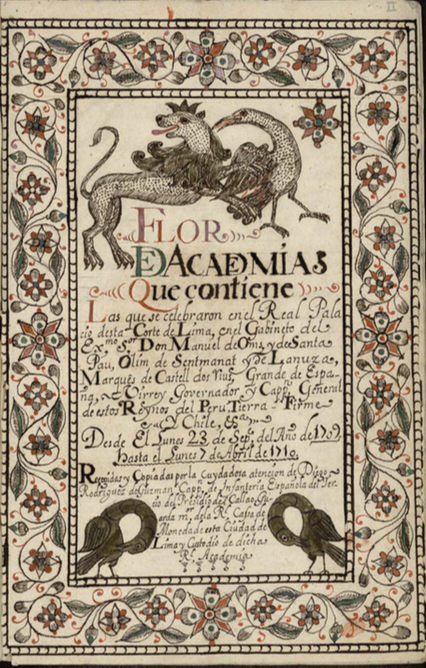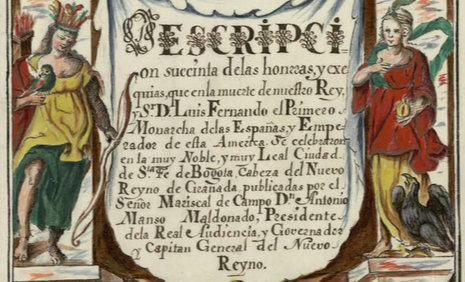Jose Guevara, former PhD student at the Institute of Latin American Studies
Colonial elites in Lima and Santa Fe de Bogotá, during 1700-1750, employed their handwriting skills to enhance their social status. The traditional view has been that elites in Spanish America improved their social position mainly through land ownership, marriage, roles in the colonial administration, and noble titles. However, the handwritten practices of the colonial elite can reveal another part of the story that has been overlooked hitherto.
Studies of the form of manuscripts usually fall in the field of book studies or written culture. For colonial Spanish America historians of the book have been interested mainly in the printed book, its production, circulation and consumption. Clearly drawing a solid line between printed and manuscript forms of books and other lettered materials hinders comprehension of the complexities of colonial intellectual and social life. Both types of materiality feed and interchange with each other in a variety of ways, which can be only understood by looking at the needs of the producers of such materials. Here, I will describe three cases in which members of the colonial elite employed manuscripts to enhance their social position.
Handwritten Texts at the Centre of the Educational Institutions
The colonial classroom was a place of production of most of the academic texts made in Lima and Santa Fe de Bogotá. The activities of teaching and learning conducted within the space of the classroom promoted writing as a tool for remembering, disseminating knowledge and acquiring prestige. The result of these processes was an abundance of manuscript books that can be divided into textbooks and notebooks.
A textbook was primarily a manuscript or printed book employed as a guide for teaching. An example of such types of books is the Compendio matemático que compuso el doctor Thomas Vicente Tosca. Que comprende aritmética superior y algebra. This printed book made in Valencia, Spain, in 1707, was probably copied in manuscript form by students in the courses of the Academia Xaveriana in Santa Fe de Bogotá. The physical resemblance between the printed and manuscript copies implies that the copyists or students had the chance to have the printed book in their hands or at least close enough to match its layout or typography. Manuscript books were also employed as textbooks when teachers made use of their own notebooks which they wrote when they were students themselves.
Handwritten notebooks were basically the texts produced by the students or other members of the academic institutions intended to preserve and remember the words of the lecturer or extracts of texts important for readers. There are many varieties of notebooks made inside educational institutions. Most of them fit in the category of handwritten books made by students as part of their requirements to earn an academic degree. Other notebooks were aimed to support the production of sermons or other texts and were called commonplace books.
Notebooks and textbooks helped members of the colonial elites in Lima and Santa Fe de Bogotá to enhance their prestige. Students used these books to earn academic degrees and promote the name of certain scholars. Most of these books enriched the humble university libraries and promoted a manuscript book culture defined by visual decorations and imagery.
Manuscript Objects at the Service of the King
In 1724, the early death of King Luis I shocked the population of Lima and Santa Fe de Bogotá. The recently appointed monarch died when many overseas territories were still celebrating his crowning. This was the case of Santa Fe de Bogotá, where news about the death of the king caught the city in a state of joy.
The colonial authorities of the city rushed to prepare the first honras de exequias made in the city. Members of the elite probably saw this as an opportunity to show the Crown that the city was able to realise a viceregal ceremony as flamboyant and elaborate as those of Lima and Mexico. The main purpose was to establish Santa Fe de Bogotá as the capital of the third viceroyalty, the viceroyalty of Nueva Granada.
A manuscript book entitled Descripción sucinta de las honras y exequias que en la muerte de nuestro Rey D. Luis Fernando el primero (Figure 1) tells the story of all the procedures and activities taken by Antonio Manso y Maldonado, the president of the province, and the members of the Real Audiencia in the production of the ceremony. Given that Santa Fe de Bogotá did not have a printing press at the time, the authorities took the decision to create a manuscript book that resembled in visual form and content the printed form of these relaciones.

However, the manuscript form of this type of text was able to present more information about the ceremonies and its textual pieces than the printed versions. Using illustration techniques, the producers of the relación produced a colourful version of the tumulus (decorated tower that was the centre of the ceremonies, which carried many textual and visual pieces in honour of the deceased character), meanwhile in the relación de exequias made in Lima for the same event, entitled Parentación real sentimiento público luctuosa pompa fúnebre solemnidad en las reales exequias del serenísimo señor don Luis I, the tumulus only appeared in black and white.
The context of the viceregal ceremonies were always an opportunity for authors to show their prowess and skills to the city. In the case of the honras fúnebres, a famous poet, member of the colonial elite, created the iconographical programme (a coherent set of visual and narrative texts employed to convey the virtues of the central character of the ceremony and to produce an emotional atmosphere to the audience). Handwritten poetry, hieroglyphics, emblems, and other texts helped authors to enhance their fame and prestige.
Fame and Poetry. Handwriting and the Literary Academies
The Marques del Castelldosrius arrived in Lima in 1707 with the aim of making the viceregal court a place of cultural and literary production. His interest on theatre, poetry and academic topics shaped his rule. During a few months between the end of 1709 and the first quarter of 1710, the gabineto of the viceregal palace became the meeting place for a new literary academy.
The sessions of the academia were recorded in a manuscript book entitled Flor de academias que se celebraron en el real palacio de Lima (Figure 2). This book handwritten probably by five escribanos contains the contributions by the members of the academia following the instructions of the viceroy. In many meetings, poets wrote improvised texts during the sessions of the academia that were based on a problem or a topic that the viceroy had set.

Through this book the viceroy aimed to enhance the image of Lima as a place of cultural production. The producers of the text aimed to circulate the book among other courts around the Empire, especially in Madrid and Mexico. The types of decorations and the efforts involved in producing a legible and clean layout illustrate the importance of this endeavour for the members of the court in Lima.
Although the study of the printing press as an agent of change has defined the research of the history of the book in the early modern period, manuscript culture was still alive in many regions of Spanish America. The purpose of my research was to call the attention of historians and librarians to the diversity of objects and uses of handwriting. It is possible that following this path we will be able to find traces of local production and more insights about the lettered culture of the colonial period.


Recent Comments